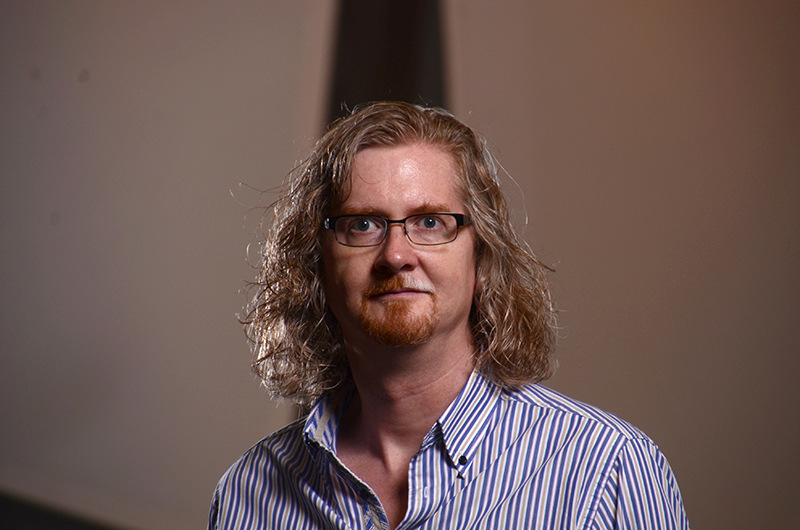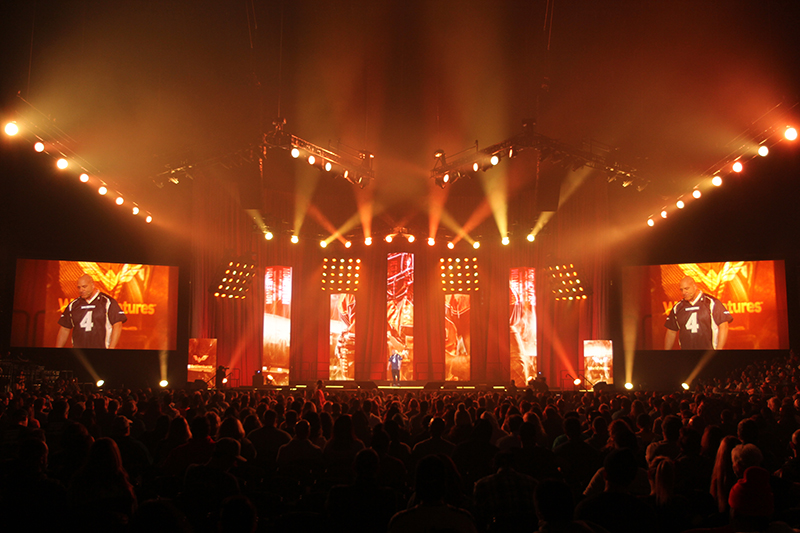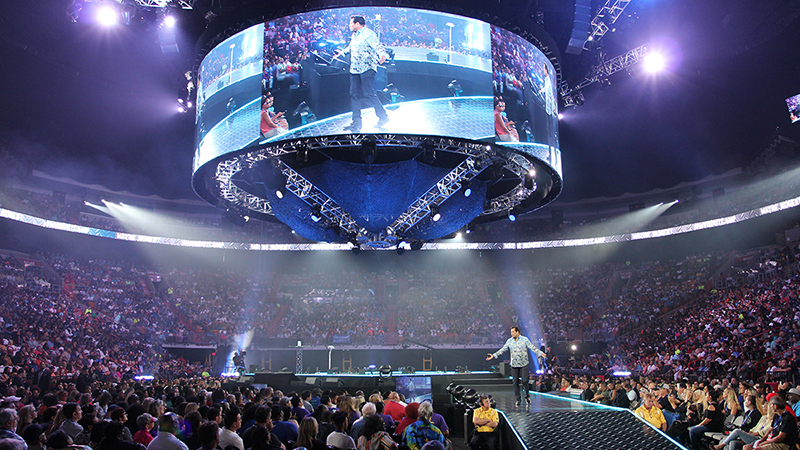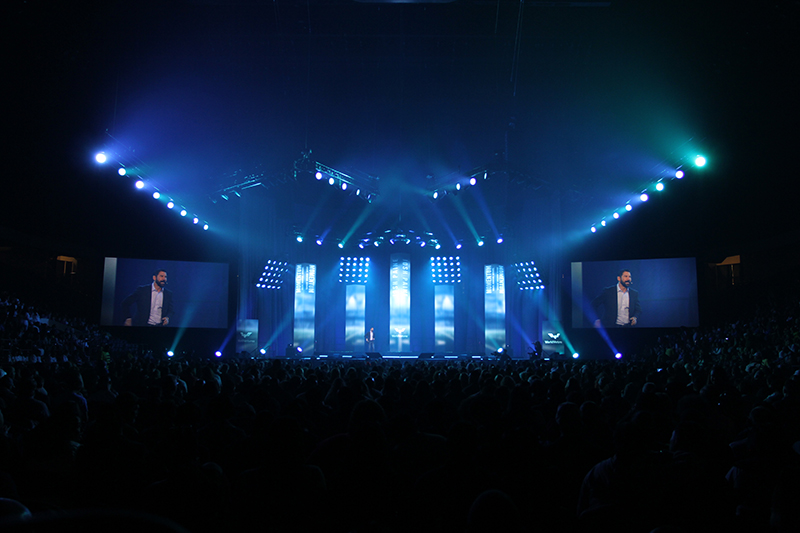
Lighting Consultant for Corporate and House of Worship Clients

If you mention lighting design taking place in houses of worship to those not engaged with that genre, you may receive a dismissive attitude from envisioning unsophisticated work. When first entering the lighting industry several decades ago, that might have described the viewpoint of Andy Dunning, a veteran lighting designer and owner of Landru Design in Nashville, TN.

A Pleasant Surprise
“Back when I was still touring, I was dubious of working with churches, as my perception was they placed little emphasis on quality with regard to production work,” comments Dunning. Which is somewhat ironic, given the source of Dunning’s inspiration for pursuing a career in lighting design. “I was pleasantly surprised to learn that I was wrong.”
“I started when I was in junior high as a volunteer in my church,” explains Dunning. “I was ‘one of those kids,’ fascinated by the equipment and people running it. I expressed an interest and started working behind the scenes. The adults were more than happy to let me run with it. We didn’t have a lot available in terms of gear back then, but we’d do something special as part of the service on Sunday, and I’d find a way to light it or run sound for it.
“Our local high school had a nice theater — this was the time of bands like Petra, Stryper and other top selling Christian bands. The school’s theater was a venue of the size that these bands would visit when in the area. I would hang out with the LDs, asked a lot of questions, helped with load-in and load-out. And I’d even get a T-shirt at the end of the night. How cool is that? The technical production bug really hit and progressed forward into asking, ‘What do I want to do with my life?’ I entered college as a radio/TV major, but after two years I transferred into fine arts theater for the remainder of college. When I graduated, I hit the road and started touring. It was the era of Sacred Warrior, One Bad Pig and other heavy metal/alternative Christian bands.”

A Different Path
Dunning toured until about 2003, when a conversation with a colleague from the road ended up changing his career direction. “He had started working for Fellowship Church, a large church in Dallas,” Dunning says. “We’d run into each other a few times a year, and he kept telling that I needed to come see what Fellowship was doing. I avoided the invitation for quite a while because of my poor perception of church tech, but eventually went and saw the incredible production work they were doing.
“That first weekend at Fellowship Church turned into working alongside their production team about six times a year for several years. I had my eyes opened to a church where quality was a priority to them. I had never been exposed to production at a house of worship being done like that before. They contracted me to help them do transitions into new teaching series and light special events. That relationship opened some doors for me, as a lot of people watched Fellowship to see what they were doing. I received a lot of calls from those gigs.”

Dunning realized at this point that there are a lot of churches out there where good quality presentation is a priority. “It changed my world and attitude towards churches,” Dunning comments. “That relationship opened the doors to a lot of other relationships. At one point, 90 percent of my year was faith-based events.”
While lighting design is lighting design no matter where you are doing it, Dunning has a special appreciation for working with churches. “Why do I love working in the church market? Because my faith is such a big part of my life. Participating in seeing the Christian faith shared with others — I love that. Secondly, working with volunteers and seeing the light bulb go on when they finally ‘get it’. When they start understanding what lighting can do to affect the worship experience — I get really happy over that.”

Secular vs. Faith-Based Projects
“In many ways, if you’re working with a church that really places a high value on good quality production, there’s little difference for me from doing secular events,” Dunning continues. “When I lead teams, I expect excellent behavior, high work ethic and integrity no matter where we are working…But when working at a church, there are some things you have to be very conscious of. You really need to be very careful about your language. What you talk about, the words you use, the jokes you tell. Things that you might snicker about on a tour bus wouldn’t be appropriate with a house of worship client. You want to be sensitive to how you spend your off hours. If a church supplies you with a hotel room, what’s going to be on the bill when it shows up a week later? Minibar usage, alcohol at meals, what pay-per-view movies you took advantage of — those things can get itemized out on the bill.
“I’m also going to be sensitive to the fact that I’m a married man, and not have dinner with a woman (even a friend) if it’s going to be just the two of us. The church might be aware I am married, and what might they be thinking if I’m out with one of their female volunteers? Perception matters significantly in the church world, not just because of how the church may look at you, but also because your actions can affect how that church is perceived in their community.”

It’s not uncommon for a church to want to have their volunteers help with production projects. This is to enable their members to serve in their church, to reduce labor costs, as well as to provide an excellent training opportunity for their volunteers. Dunning has some thoughts on how to prepare for this. “When utilizing church volunteers, you need to be prepared to go into the project with a lot of patience. Your volunteers may or may not be experienced. And even those with experience may have a narrow exposure to the production world outside of what has been done at that church. However, church techs are always eager to learn new things that can expand their abilities, so approaching a church project prepared to spend time teaching and coaching, it will be very well received.”
Dunning continues, “Just like with a corporate event, when you first step in, you need to figure out who’s in charge. It’s the same thing in a church. Who is really in charge of this event? It might not be who you expect it to be.” And churches often have a large number of events happening each week, so their staff’s time is spread thin, sometimes causing there to be less detail in an event plan than they would ideally prefer.
Every environment goes through trends, and houses of worship are no exception. “The biggest trend I’m seeing in church lighting design,” states Dunning, “is that increasingly there are no dimmers in the room at all. Constant power and ethernet are run all over the room, and all light sources are LED and arc source.”
Enhancing the Message
“From a usage perspective,” Dunning continues, “because good quality, low-power color changing fixtures are becoming cost effective, more churches are learning what they can do to enhance the tone and mood of the service through the use of color and also intelligent fixtures. This also means that, much like any other production environment, it is easy to fall into the trap of allowing the effects and lighting to become a light show and distract from the service. Some lighting volunteers think that just because they can make it wiggle or change color, they should do so. Church lighting volunteers need to learn the importance of using restraint. For any given segment of a service, they should learn to pick a color palette and not stray from it.”
Dunning does, however, encounter many churches that have learned to master the art of restraint. “I love it when I go into a church and the lighting is done so well it doesn’t call attention to itself unnecessarily. I have a ton of respect for that. I appreciate church LDs when they have a lot of fixtures in the air but aren’t using all of them all of the time. Again — showing a level of restraint. Along with that, I love when a piece of music has a given tone and the team has really enhanced that tone appropriately, and it just works.”
Lighting is a rapidly changing field, technology-wise, and Dunning has a word of advice to theatrical lighting venues. “They need to start paying attention to where lighting is heading with regard to Green resolutions. While most current regulations exempt theatrical fixtures, that could change in the future, and those resolutions fueling further development and refinement of LED technologies should increasingly make incandescent lamps obsolete. Churches may one day find they can no longer purchase lamps for their traditionally-lamped lighting fixtures.”
Dunning currently stays busy with a lot of corporate events, some church lighting projects and developing and maintaining a line of software plug-in products for Vectorworks. He has developed plug-ins for visualizing a wide range of video display devices, soft goods, staging elements, stage lifts, stanchions and audio products in Vectorworks.
Jim Kumorek, owner of Spreading Flames Media, provides clients with video production, photography and writing services along with training services. He can be reached at www.spreadingflamesmedia.com.


